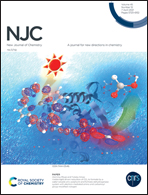Magnetism, dielectrics and ion conduction in two polymorphs of a heteroleptic bis(dithiolato)nickelate molecular solid†
Abstract
Homoleptic metal-bis-1,2-dithiolene complexes have been intensively investigated and they show frequently a spin-Peierls-type transition owing to strong spin–lattice coupling. However, heteroleptic metal-bis-1,2-dithiolene complexes have been rarely reported and they display novel physical properties. Herein, we report a new heteroleptic compound [Et3(n-Pr)N][Ni(dmit)(mnt)] (1) (Et3(n-Pr)N+ = triethylpropylammonium, dmit2− = 2-thioxo-1,3-dithiole-4,5-dithiolate, mnt2− = maleonitriledithiolate), which was prepared through ligand exchange reaction. 1 has two crystal polymorphs, labeled as 1α and 1β, which can be identified by powder X-ray diffraction (PXRD) technology. The two crystal polymorphs show different crystal structures, and the alignment styles of the neighboring anions show a great difference between 1α and 1β. The crystal structure optimization revealed that 1α is a stable crystal lattice with a little difference between optimized and original structures, while 1β may be an unstable crystal form. Both 1α and 1β show Curie–Weiss-type paramagnetic magnetic character in the whole temperature regions. In addition, the dielectric properties of 1α and 1β disclosed that there existed a dielectric anomaly in 1β, but not in 1α, which resulted from the structural phase change in 1β with the change in temperature. The critical temperature of the dielectric phase transition almost coincides with that obtained by dielectric relaxation and impedance analysis.



 Please wait while we load your content...
Please wait while we load your content...